Drumming Without A Drumset
If you’re like a lot of musically inclined people you want to learn how to play the drums, but you’re not ready to invest in an expensive, bulky drumset. So what can you do? Well, quite a lot actually!
Yes, learning on a real drumkit will have its advantages. It will expand the sounds you can play with which could inspire new rhythms and sticking combinations. A kit also adds your feet into your rhythms, adding a completely new dimension to your playing. But, if you want to learn drums RIGHT NOW your can definitely sink your teeth into beginner lessons with just a pair of drumsticks and your imagination. Today we’re going to look at different ways you can practice the drums without owning a drumkit.
Just Snare Stuff
You’ll only ever be as good as the control you have over your sticks and the rhythms you can think of in your head. And trust me, you don’t need a lot to get better at these things! In fact, you only really need one drum and a pair of sticks. But, as this post suggests, you don’t even need a drum!
The first and most important drum on a drumset is the snare. This is the drum that sits in between your legs and usually has a white drum head. This drum also has thin coiled wires which run taut along the bottom which give this drum its characteristic raspy sound. This is the drum you hear very often on the backbeat—on the “2” and “4”—in most songs. As a drummer you’re going to use this drum the most, by far. This is the drum we’re going to try to replicate so you can practice.
Like I said, you don’t have to buy the drum, but you are going to have to buy a pair of drum sticks. (If you wanna be really intense about not spending any money I guess you don’t really have to buy sticks. You could just practice rhythms by tapping your lap or something. But stick control is such a crucial thing if you ever decide to move to a drumkit that I’d strongly recommend starting with at least sticks. Don’t worry though, a good pair are only like ten bucks at your local music store or on amazon.)
But not all sticks are created equal, and you’re going to have to pick which ones are right for you. So I’ll really quickly run you through the basics of choosing the right drumsticks. If you wanna go more in depth with this topic I’m going to be writing a post on this, so keep a look out for it!
Choosing Sticks
Here’s a quick low-down on which sticks to get. The most common size are 5A’s, which is good for all types of drumming, and probably the best bet for most people. But if you have big hands like me you might want to want to go for bigger sticks like 5B’s, which are what I use. If your hands are a little smaller I’d go for 7A’s, or even child sized sticks. If you go to your local music store they should have a nice selection to choose from.
In terms of brand, there are tons to choose from, but don’t overthink it. In the end sticks are just sticks, and who makes them doesn’t really matter. I really like Vic Firth, but that’s mostly because those were the first sticks I bought and the brand my drum teacher used. I guess they’re also marketed to jazz people more than any other brand and I like to pretend to be sophisticated.
Now that you have your sticks you’re going to need something to play them on!
Practice Pad or No Practice Pad?
For that I’d recommend you getting your hands on a practice pad. You can play on other surfaces, which I’ll talk about in a second, but starting your technique with a practice surface that replicates a real drum is a pretty good idea. There are so many different practice pads out there, but they all essentially do the same thing so I’d recommend you get the cheapest one you can find
Another alternative to a practice pad is to get these cool practice tips that you just put on your drum sticks. I’ve never used them but they seem like a pretty good idea! I’d just be scared of losing them.
If you don’t have a practice pad, or you’re desperately waiting for it to arrive, you still have options! Something I like to do is put a kitchen towel or a folded t-shirt over a hard surface and use that. It will be sort of loud (though not as loud as a real drum kit) but it will simulate the bounce of a real snare drum well enough.
There you go! with a pair of sticks and something to practice basic rhythms you are well on your way to learning what you need to master the drums!
But once you’ve gotten this far you’re left with the next question of…
What Should I Practice?
People often forget that the key to being good at the drums isn’t in the ability to play complicated ideas. It’s in knowing your ideas and playing those ideas clearly and cleanly. However, doing this doesn’t come quickly or without effort. Like so many things it takes a lot of practice! In my years of teaching I’ve discovered you need three things to get good at drums:
1. Learn how to read music.
2. Learn rudiments and technique
3. Come up with your own ideas.
Let’s break these down.
Learn How To Read Music
Music notation is the language of music. If you have no way to record and remember your ideas, or the ideas of others, you’re going to be at a major handicap. It’s like trying to become fluent in French without ever having even learned the alphabet!
And trust me, learning to read music really isn’t that hard! Just check out my post (I’ve yet to write, sorry) to dip your feet into it. I swear it’s easy enough for anyone to do. When you’re ready to move beyond that get a good beginner drum book and work through it. This one’s my favourite, but there’s like a million out there to choose from.
Once you get confident with your reading we can start with step 2, which is…
Rudiments and Technique
No matter what skill level you’re at you can always practice your rudiments. They are the fundamental building blocks from which all the rest of your drumming will be built, and they are so important to getting good stick control. You want to know them well. Play them over and over and over and over again. And then again. Meditate to them. You’re looking to perfect your muscle memory.
Start with the basics. Play your single strokes (R L R L R L R L) for like ten minutes, or until you don’t have to think anymore. Try going up and down in tempo as well as volume to really stretch your stick control.
Next play double strokes (R R L L R R L L). Play for the same amount of time, and again vary your tempo and intensity.
Next do your Paradiddles (R L R R L R L L). Again, same time, same deal with tempo and volume.
After this you can start working on all the other rudiments. Here’s a pdf (again, I’ve yet to make) with all the official ones, plus a few extra I think are important.
Sometimes working on your rudiments can get a little boring. Sometimes if I’m practicing them but falling asleep I put on some music and play the rudiments in time to the song, or else I put on a podcast or Netflix or something. Other times I really like the repetition of them and I can fall into trance-like state. That’s fun too.
Once you get pretty good at the rudiments I’d get a book of snare solos. This is the one I have, and it’s awesome. All the solos are very musical and playful, and just sound good. Practice these, not just so you can play them through but so you can play them through cleanly and quickly. They might sound really march-y but storing these ideas in your muscle memory really help you out when you start soloing and you need to come up with your own ideas. Speaking of which, the next thing we’re talking about is…
Coming Up With Your Own Ideas
This is what drumming is all about! Drums are the improvisational instrument. More than any other instrument we are given free rein to play whatever we want, however we want, whenever we want. We don’t have to follow chord structure or any specific melody. We don’t even have to repeat the same fills all the way through the song. As long as we play in the same time signature as the others (but not even always! We’ll talk about implied metric modulation sometime) and are playing something that fits with the mood, or contrasts it in a cool way, then then we’ve succeeded as drummers!
This section is a little harder to talk about because this is really where you inject your own style and character into your playing, and developing this is something only you can do. Play what excites you. Play the ideas you think are cool. Write your own “melodies”. Try and mess with people’s ear. Try to be playful with the audience. Surprise them! Play things you feel could only come uniquely from you.
Coming up with your own ideas and soloing are huge topics, and they probably deserve their own website. I’ll try my best to write a post on those subjects another time.
Cool. So I think that’s all I’m going to talk about when it comes to only playing snare stuff. Now let’s talk about how to get a feeling for the whole kit.
Replicating A Whole Kit
First we should quickly go over the different parts of a drumset because you’re going to be trying to replicate these. Actually, you know, let me just show you a picture. I think that would be easiest.
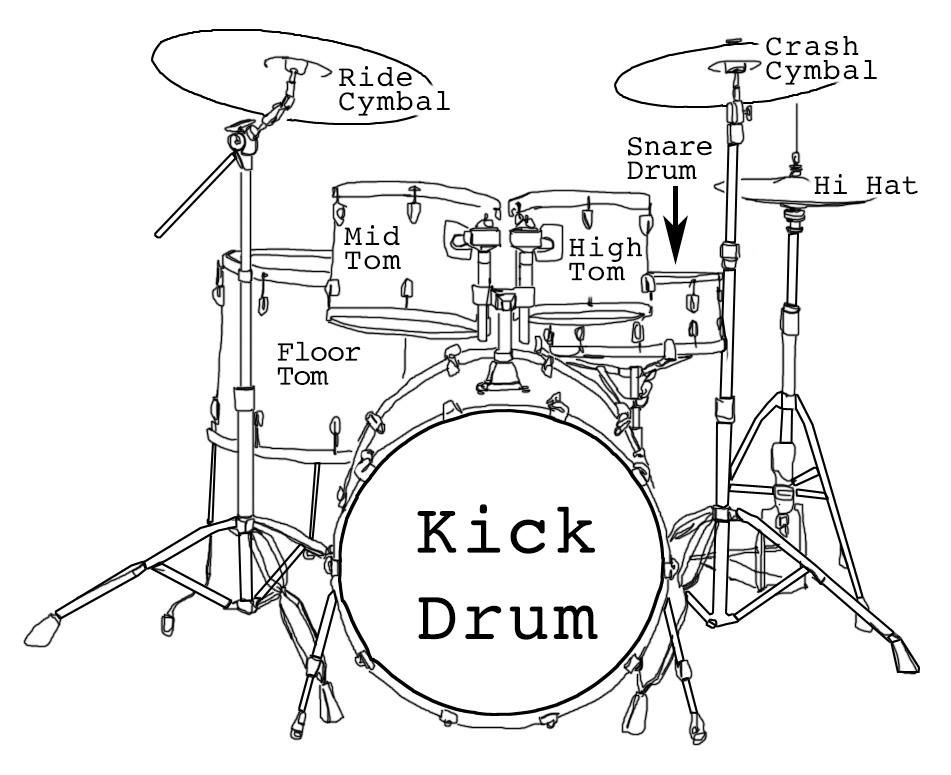
After the snare, which we’ve already gone over, the second part of the kit we’re going to try to replicate is the kick drum. This is the big drum that sits on the ground in front of you which you hit with a kick pedal. It makes a big, low, booming sound which usually emphasizes the first and third counts of the measure.
The kick is going to be the easiest to simulate. Just like you would tap your toe to the beat, what you can do is pretend that tapping your foot on the ground is you engaging the foot pedal to the kickdrum.
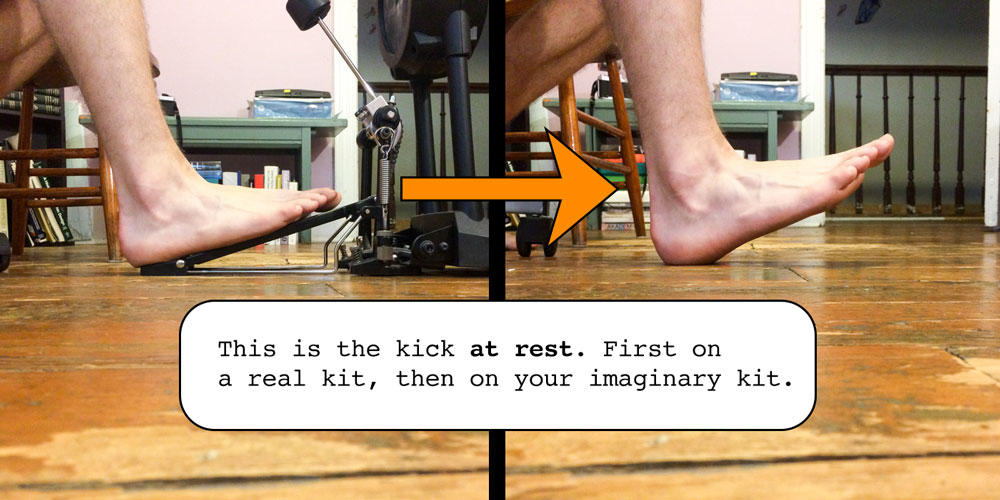
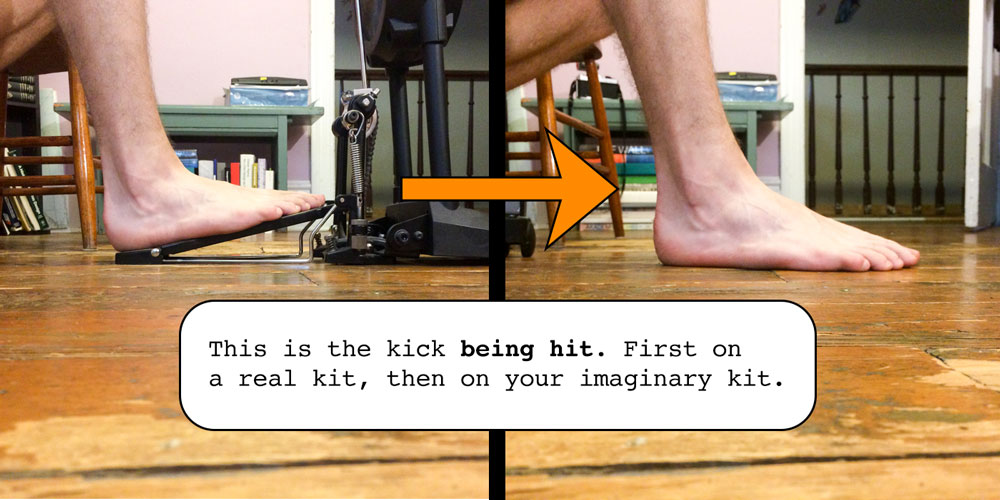
The final piece of the drumkit we’re going to replicate is the hi hat. This is the stand and two cymbals that you can open and shut with a foot pedal. Typically you use your right hand (crossed over your left which is on the snare) for steady, repetitive strikes on the hi hat. Being able to find a sturdy, raised, padded surface for the hi hat is what we’re after. But where on earth are we going to find something like that?
Alright. Are you guys ready? Here we go.
The Solution
What I learned a long time ago as an eager, young, broke, aspiring drum student was this: If I took one of my parent’s kitchen chairs and spun it around I could use the seat as a snare drum and the backrest as a hi hat and crash cymbal, then just tap my foot on the ground for a kickdrum. And voila! With a kitchen chair and some imagination you have a basic structure for a full drumkit! With this you can practice drum beats, fills, and play along to songs without a drumset.

If you really want to pretend that you’re playing more of a kit you can grab another chair and use that as a floor tom for when you’re doing fills.
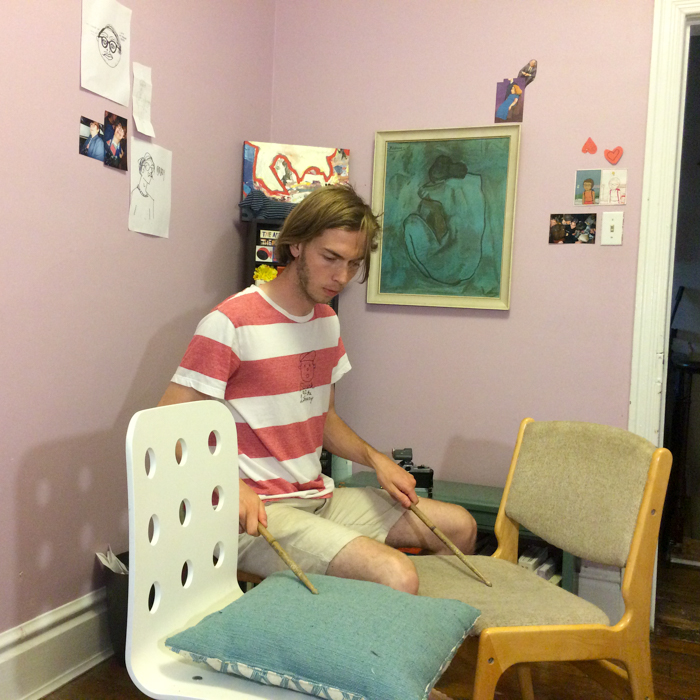
The Last Thing To Make It Real
Now that you’ve got your fake drumkit set up, try doing one more thing. It sounds a little weird, but I swear it’s going to help your imagination powered drum set work even better.
First thing is relax. Go one at a time through each drum and cymbal. Hit the “snare”, and when you do, really imagine the snare sound as you strike. (If you don’t know what a snare sounds like try looking up a video on YouTube.) Do this for each drum and cymbal you’re going to use for about a minute each, or as long as you want. Now when you start playing your brain will partially fill in the sounds that are missing.
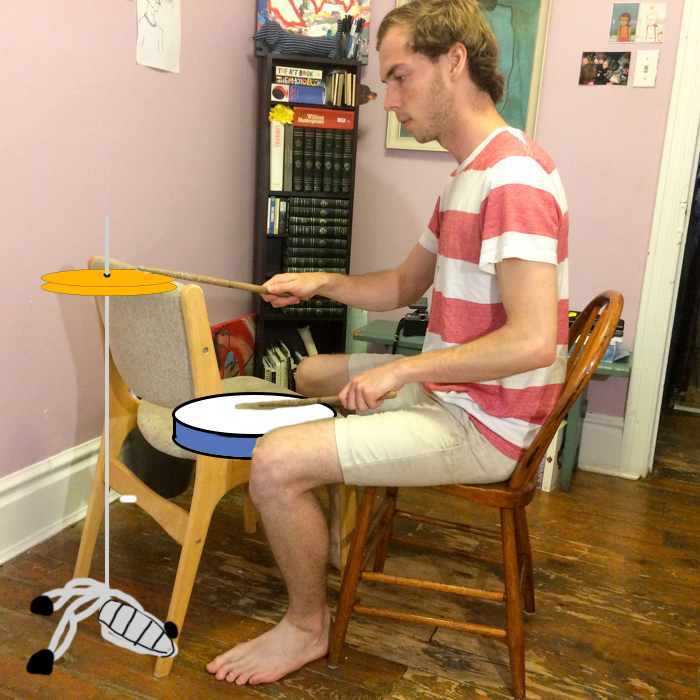
(I know, I know, I’m a master drawer. I should’ve made a website about that instead.)
Once your imagined drumset is creating real noise inside your head, try learning some beats! A great place to start is my post on how to play a basic rock beat, and once you’ve done that try to teach yourself some other beginner drum beats.
Thanks everyone! Happy Hitting Things!
Chris